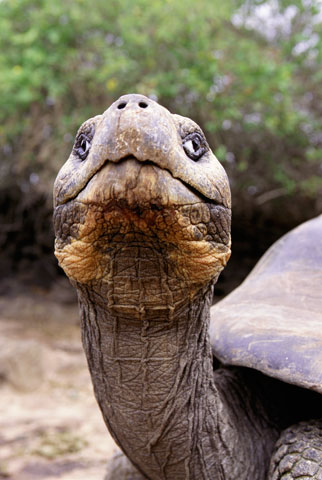
A Galapagos giant tortoise at the Charles Darwin Research Station on the Galapagos Islands (Newscom/Martin Harvey)
 ASK THE BEASTS: DARWIN AND THE GOD OF LOVE
ASK THE BEASTS: DARWIN AND THE GOD OF LOVE
By Elizabeth A. Johnson
Published by Bloomsbury Publishing, $32.95
The best kind of discussion is not an argument. Although the thrust and parry of intellectual conflict can be stimulating, it is rarely productive. The best kind of discussion is dialogue, when two entities openly and honestly share ideas and accept the best from each other's perspective.
In Ask the Beasts: Darwin and the God of Love, theologian St. Joseph Sr. Elizabeth Johnson embraces the task of showing how Christian theology can speak productively with Darwin's theory of evolution. This book begins with the question, "What is the theological meaning of the natural world of life?" The importance of nature in cosmic existence is something that theologians have only recently begun to examine seriously, but scientists have been at it for centuries. Why not, then, look to science to find insights that can be considered from a theological perspective?
Johnson's book is a sustained dialogue between science and theology, and she notes that although each discipline answers different questions, both are bearers of important truth about the world. Her specific dialogue partners are Darwin's On the Origin of Species and the Nicene Creed.
She accepts the theory of evolution that was described in On the Origin of Species as a scientifically demonstrated interpretation of the natural world. She embraces the Nicene Creed as a narrative of divine engagement. It is a bold move, but one that sparks fire to the heart and the imagination.
On the Origin of Species describes a natural world where the tree of life is constantly in flux, with unimaginable potential for growth and change. The creed and resulting Christian theology describe the tree of the cross as a point at which the ineffable God, who has come physically into this created world, redeems and unfolds the unlimited potential of all of created matter. In the creed, we have the creator, the vivifying spirit, and the redeemer of creation.
Johnson's descriptions of Darwin and his ideas give the scientist humanity and depth. We see not the modern-day caricature, but a man whose love for the natural world was so great he spent his entire life focused on studying its origin and variations. We see a scientific ascetic, seeking truth as diligently as any monk.
Johnson shows us a man who spent hours on his hands and knees in the dirt, happy to examine the detail and complexity of even a small plot of this grand world. She brings Darwin and his ideas to us most completely by providing an excerpt of his great book:
It is interesting to contemplate an entangled bank, clothed with many plants of many kinds, with birds singing on the bushes, with various insects flitting about, and with worms crawling through the damp earth, and to reflect that these elaborately constructed forms, so different from each other, and dependent on each other in so complex a manner, have all been produced by laws acting around us.
Johnson unloads the argumentative baggage stacked over the years, and shows that Darwin's work was not a direct assault on religion. Instead, she describes a theory that simply challenged the existing 19th-century scientific concept that each species of life in the world were the result of special acts of creation, with nothing new entering the system. Yes, this scientific theory was developed through the lens of Genesis, but, in truth, Darwin's ideas were as offensive to the scientists of his age as they were to the religious thinkers.
Johnson sees no reason to do war with the theory of evolution, but embraces it as a scientific insight that can further our theological thinking about nature and creation. She writes, "What a great scientific advance like this offers is certainly not an answer to every question but a suite of insights that lead to new ideas and new questions which deserve attention."
There is randomness and mutability in the scientific theory of evolution, but it is possible for mutability and chance to also be taken into theological consideration. Johnson argues that creation can exist in ontological dependence and operational autonomy. She asserts that there is growth in God, for both humans and other living species.
Johnson takes the 12th chapter of the Book of Job for her theological North Star:
Ask the beasts and they will
teach you;
The birds of the air, and they
will tell you;
Ask the plants of the earth
and they will teach you;
And the fish of the sea will
declare to you.
Who among these does not
know
That the hand of the Lord
has done this?
In his hand is the life of
every living thing,
And the breath of every
human being.
Johnson posits that the philosophical systems of Hellenistic dualism, patriarchal androcentrism and Cartesian dualism influenced theological thinking and squeezed earth and its myriad of creatures out to the edges of Christianity's spiritual concerns. She says that the additional development of a narrow interpretation of Genesis, and a resulting focus on the troubles of humanity, theologically separated humanity from the created world. If we can unload this baggage, then we can see that the elements for a theology of creation exist, and have always existed, in Christian Scripture and theology. There is no need for mutation here.
There have been Christian thinkers over the centuries who pondered the place of the natural world in seeking to understand our place in the cosmos. This is what Johnson calls a "subterranean stream of creation theology." Such thinkers include Irenaeus, the mature Augustine, the desert fathers and mothers, first-millennium Celtic saints, Hildegard of Bingen, Meister Eckhart, Julian of Norwich, Teilhard de Chardin, Eastern Orthodox theologians and, of course, Francis of Assisi.
Johnson advises that a new theology of creation must look to all of the Trinitarian elements embraced in the Nicene Creed -- including the Son and the Spirit. The Holy Spirit moves through the natural world, sustaining and enlivening it. The Son took on material form, embraced and sanctified it. Jesus healed with spit, dirt and touch. He lived in our natural cycle of suffering and pain, and screamed at a violent death, as would any other living creature. The Son was "the presence of divine love in the flesh enacting an historical solidarity with all who suffer and die." What else do we need to convince us that the magnificent organism of our natural world is a holy place?
Our world evolved in all its splendor without human help, Johnson reminds us. In fact, the brief existence of humans in this creation, for all of our intelligence and talk of virtue, has quickly brought destruction and exponential extinction to the natural world. She invites us to conversion and suggests that we might even embrace a new asceticism- -- an earth-affirming discipline that frees us from enslavement to market practices that harm other living creatures.
This book is a call to broaden our focus, beyond the hierarchy we have perceived in Genesis, beyond the individualistic angst of human sin and redemption. It shows us that biblical revelation is bigger than this -- God is bigger than this.
[Melissa Jones teaches religious studies at Brandman University in Irvine, Calif.]




